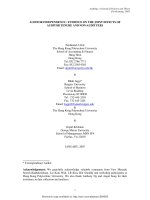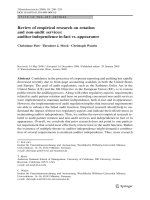Restrictive and non restrictive relative clauses
Bạn đang xem bản rút gọn của tài liệu. Xem và tải ngay bản đầy đủ của tài liệu tại đây (11.17 KB, 1 trang )
Restrictive and non-restrictive relative clauses
The relative pronouns who and which can be used to identify or define nouns. They tell us which person or thing
we are talking about.
The man who had cheated me was arrested by the police.
Here the relative clause introduced by the relative pronoun who identifies the noun man. Which man? – the one
who cheated me.
The book which you see on the table is my favorite. (Which book? – the one you see on the table)
Such a relative clause which defines or identifies its antecedent (the noun phrase) is called a defining or
restrictive relative clause.
Restrictive relative clauses follow immediately after the noun that they modify. They are not separated by pauses
in speech or commas in writing. Note that a restrictive relative clause cannot be left out without affecting the
meaning of the sentence.
When a relative clause merely gives some additional information about the noun, it is called a non-defining or
non-restrictive relative clause. Note that a non-restrictive relative clause is not necessary for the identification of
the noun.
My brother, who is a doctor, lives abroad. (Here the relative clause who is a doctor doesn’t identify the
noun my brother. It merely gives some additional information.)
Ann, who works with my brother, is a post graduate in psychology. (Here the relative clause who works
with my brother merely gives some additional information about Ann.)
Note that in writing a non-defining or non-restrictive relative clause is separated from the main clause by commas.
A non-defining relative clause can be easily left out.
For example, the pair of sentences given below convey the same information. The second sentence just happens
to give some additional information.
Ann is a postgraduate in psychology.
Ann, who was my senior at university, is a postgraduate in psychology.
Stay on top of your writing! Download our grammar guide from www.englishgrammar.org to stay up-to-date.
Powered by TCPDF (www.tcpdf.org)







